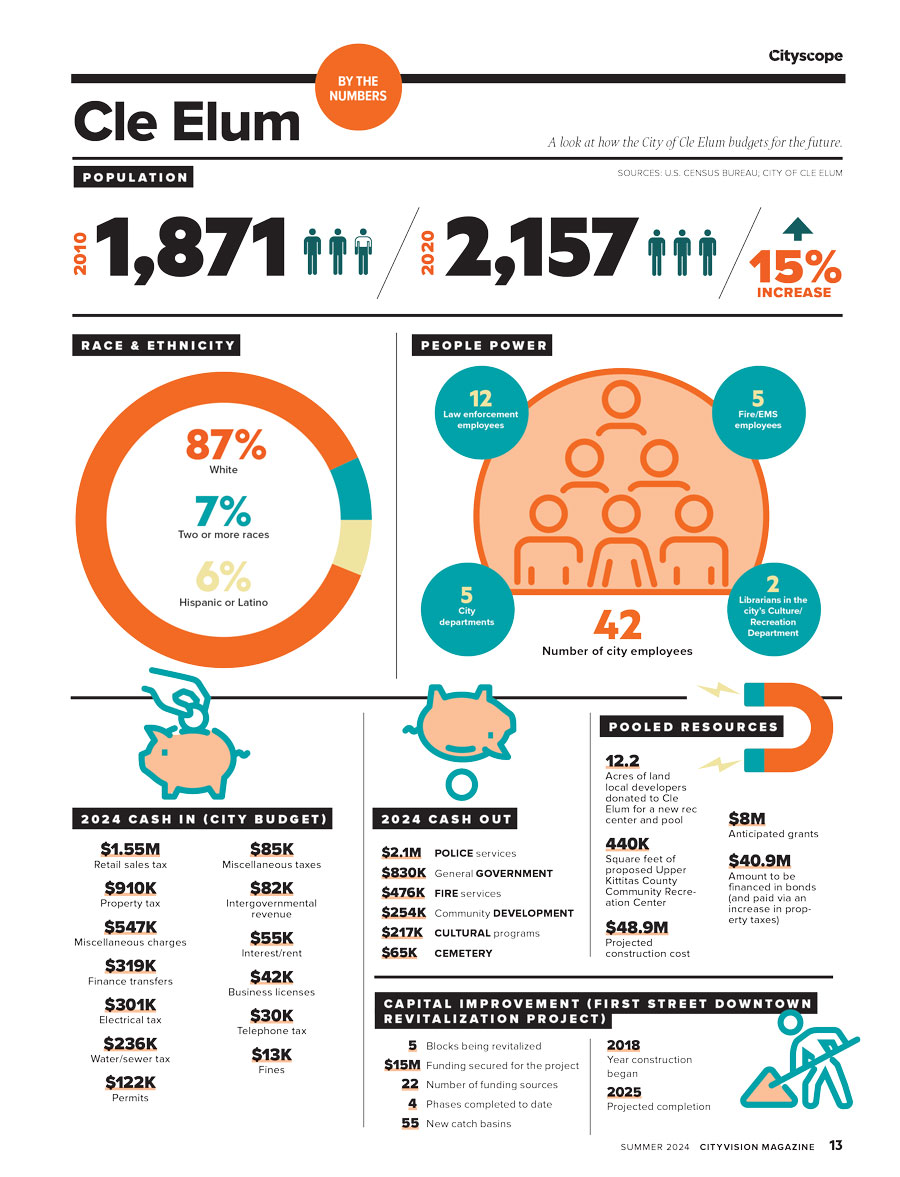AWC board member and Cle Elum Mayor Matthew Lundh on how local leaders need to rely on each other, and leverage available resources, to better plan for the future.
By Jennifer Krazit
You grew up in Seattle. What brought you to Cle Elum?
My wife, Taryn, and I moved here in 2017 soon after having our first child. I always joke that Cle Elum is everyone’s rest stop, because we’re half-way to everywhere and the first services you come to after you come over Snoqualmie Pass. When we lived in Seattle, we stopped here a lot on our way to visit my wife’s family in the Spokane area. We always thought it would be a nice place to live, so we decided to make it our home. We now have a 5-year-old son and a 7-year-old daughter.
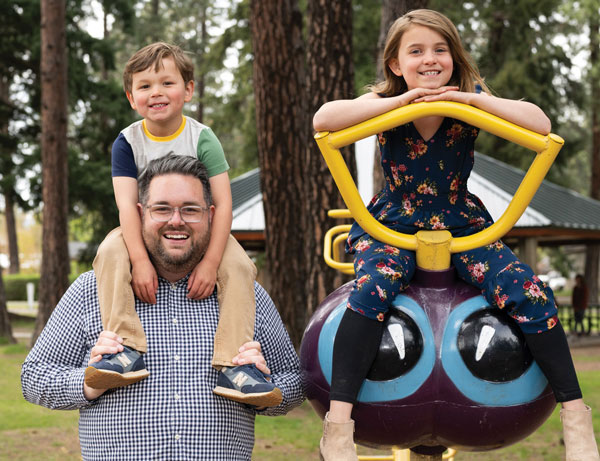
Mayor Lundh with his son, Sören, and daughter, Svea, at Cle Elum City Park. Credit: Chona Kasinger
You served on the Cle Elum planning commission and council before being elected mayor in January of this year. What prompted you to run for office?
I started going to city council meetings right after moving here, because I’m a government nerd. I decided to run for city council mostly because I have a heart for service. I door-knocked every voter in the city that year. I felt it was important for me, being new to the city, to introduce myself and hear what people were concerned about. Then when I ran for mayor and knocked on every door again, people remembered that I had come and knocked on their door four years prior.
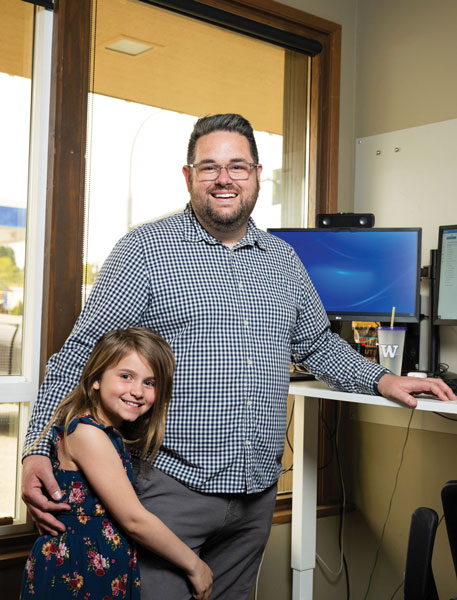
With daughter, Svea, in the mayor’s office at city hall. Credit: Chona Kasinger
You also joined the local Rotary Club soon after moving to Cle Elum. What prompted that?
I grew up with a grandfather who’d been in Rotary for 60 years. I always respected it and wanted to join once I settled somewhere long-term, and one of the first things I did in Cle Elum was join Rotary. It’s an amazing organization that makes a tremendous impact in Cle Elum through projects big and small. This year we’ll give away almost $130,000 in scholarships, supporting about half the high school’s graduating class. We raised almost $300,000 to complete the first phase of a new skate park, and now we’re raising another $400,000 to build the second phase.
In February, you were appointed to the Association of Washington Cities board. Why did you want to get involved with AWC?
AWC is important because becoming a local elected official isn’t something people train for. A lot of people decide they want to give back to the community in a deeper way, and running for city council or office is a way to do that. But there’s a lot to learn. Some cities are really good about providing resources and training—Cle Elum wasn’t. AWC helped me learn more about the job I’d been elected to do. It was a good way to meet other officials so I could learn from and bounce ideas off them as I undertook this important position. AWC affords those opportunities unlike any other organization I know of.
As an AWC board member, you represent District 4, comprising 19 cities and towns in Kittitas and Yakima counties. What’s your focus and goal in that position, and what resources does AWC provide to help you succeed? As a resource for local elected officials in those cities, my goal as a board member is to make sure that I’m available for people to call and just be a sounding board or a free therapist. Some questions seem like they should be easy to answer but aren’t always. I got to go to my first Mayors Exchange, which is an event AWC does twice a year so mayors can get together and learn from each other. There are very few people in this state who currently hold the title of mayor; it’s a pretty small group of people who understand the unique challenges of having that job. Having the chance to get together and collaborate is so helpful.
In addition to being Cle Elum’s mayor, what do you do for a living?
I own a marketing and advertising agency working primarily with local governments, campaigns, and nonprofits. Most of the work we do is in Washington state. I generally work with candidates at the county and local levels because that’s what I’m passionate about.
What does that experience bring to your role as mayor and AWC board member?
I think it gives me a different perspective. As local leaders, we avoid getting into “big P” politics. But as far as “small P” politics go, there is a political cost to the decisions you make. Sometimes you have to make an unpopular decision in the court of public opinion because it is the right thing to do for your city. It’s helpful to be able to foresee those things and mitigate them. Having dealt with elected officials across the state has helped me avoid some those landmines that are easily avoidable.
We’re a gateway to recreation, and we’re uniquely situated for people to stop for gas, groceries, or beer. The first street downtown revitalization project was designed to make First Street a place people want to hang out and walk and explore.
You mentioned that many visitors consider Cle Elum to be a stopover town. Why is that?
We’re a gateway to recreation, and we’re uniquely situated for people to stop for gas, groceries, or beer. There used to be a sign as you entered town that said “Cle Elum: Easy through access.” We want people to stop and experience our great businesses and all the city has to offer, but our main street is a state highway, and our downtown is many blocks long. It’s hard to get people to get out of their cars and walk if you don’t have attractive sidewalks, outdoor restaurant seating, or space for businesses to showcase their wares. The First Street Downtown Revitalization Project was designed to make First Street of a place people want to hang out and walk and explore.
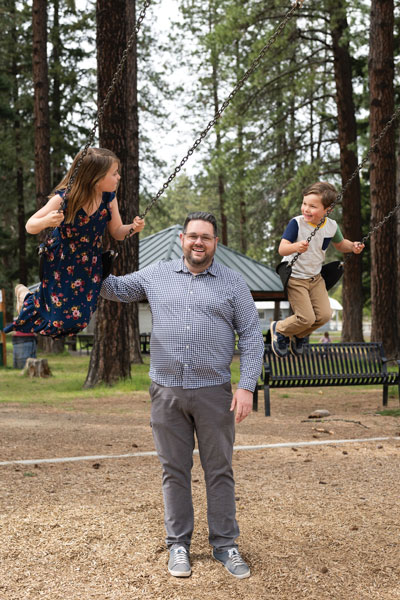
Mayor Lundh with his son, Sören, and daughter, Svea, at Cle Elum City Park. Credit: Chona Kasinger
How specifically?
We’re putting in wider sidewalks with bulb-outs on corners and mid-street crosswalks to improve pedestrian safety. We installed a storm-water system and created more parking by switching to angle parking. New light poles have better lighting and allow us to put big banners across First Street and decorate with lights at Christmas. We added street trees and benches, all those things you need to make it a place where people want to get out and explore. One of the really nice things is that these changes have a natural calming effect on speed and traffic.
After six years, the First Street Downtown Revitalization Project is nearly complete. How did Cle Elum do that so quickly?
The city took out a loan in 2016 to fund the complete design of a project that was shovel-ready, and that was a really smart decision. It allowed us to raise $15 million in grant funding from 22 different agencies. We’ve done it in a phased approach so we could tackle new sections as we got funding. We started at one end of downtown in 2018, then we did the other end and worked inward from there. Late last year, we learned of surplus federal funds that the state could distribute for shovel-ready projects. Since we had that design ready to go, we were able to get $6.4 million of federal funding in a matter of weeks, and the final phase began in early April.
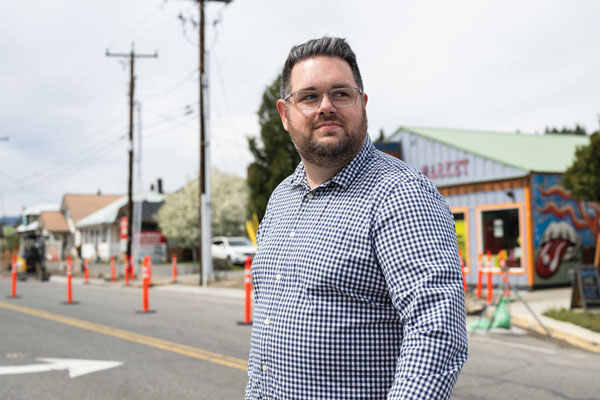
Cle Elum’s First Street is in the final stages of revitalization. Credit: Chona Kasinger
Your advice to small cities seeking to fast-track a downtown revitalization project?
Maintain good relationships with your legislators and members of Congress. Invest in going out for grants. There’s a lot of money out there, and small communities often have a leg up in the process. It’s hard because grants are expensive to write. But one of the best investments a small city can make is to hire someone to write those grants. It’s a small investment that can net you hundreds of thousands of dollars.
More than a decade ago, Cle Elum entered into two agreements that would double or triple its size. Where do those stand?
Two large portions of the city are under long-term development agreements. One was approved in 2011 and calls for up to 962 dwelling units on 358 acres. Dealing with a really old agreement has been
a tumultuous process that has caused a lot of litigation. Another agreement, from 2002, calls for 1,334 dwelling units plus 50 units of affordable housing and a 75-acre business park, with about half of the property remaining open space. These will significantly increase the size of the town.
Lessons learned?
Development is hard, and people don’t like to see the places they love change. Both of the affected areas are places where locals recreated as kids. On-e bright spot is that one of those agreements calls for 12 acres to be given to the city to create a community recreation center. We’re planning a center that will have aquatic facilities, gyms, party rooms, and things that the public really needs.
When looking at development agreements, make sure you have the right people on your team to review these contracts. They have big implications, so it’s important that you’re considering the mitigations and protections you can put in place. And if you ever see the words “binding arbitration” in a contract, run away.
Your advice to local leaders when it comes to planning for the future?
Really think long and hard about what your community values about your community. I hear people say, “Oh, Cle Elum is ruined because it’s grown so much.” My thought is that growth is inevitable. It’s going to happen. We can participate in it and retain the things we value most about this community as we grow, but that requires us all engaging and deciding what makes Cle Elum, Cle Elum. So, as you deal with growth, be mindful of what attributes maintain that feeling so that the character and heritage of the community are retained for the future.
